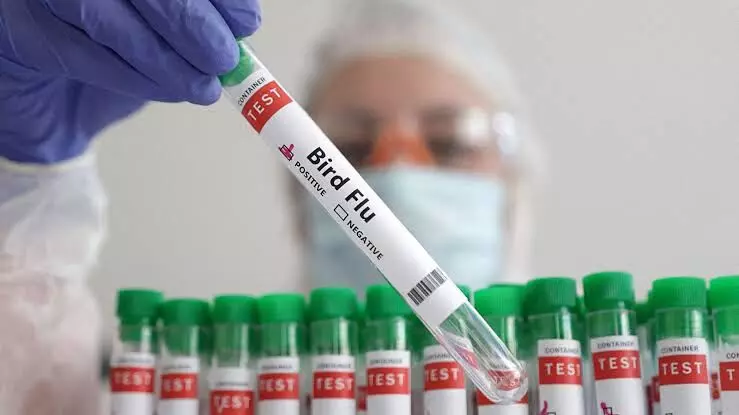Bird flu: Andhra Pradesh among 4 states report outbreak; experts call for testing
Even as the bird flu outbreak continues across different continents, a four-year-old child from West Bengal has been found infected with a variant, H9N2
By Neelambaran A
Hyderabad: The recent outbreak of bird flu (H5N1) and its sub-variants has sent shock waves across communities.
Cases have been reported in cows, domestic cats, mice, and humans across the globe including the US and India. Those who have contracted the infection are found to have had exposure to dairy farms and poultry.
Even as the bird flu outbreak continues across different continents, a four-year-old child from West Bengal has been found infected with a variant, H9N2. This marks the second human case of bird flu in India, with the first being identified in 2019. Four Indian states—Andhra Pradesh, Maharashtra, Kerala, and Jharkhand—have already reported outbreaks, resulting in the death of wild birds and, the culling of birds and ducks.
Dairy and poultry products are essential components of diets, aiding in boosting muscle and bone strength, heart health, and maintaining a healthy body weight. However, the potential transmission of the virus from human to human through the air could lead to an epidemic.
‘Enhanced Surveillance Required’
India is the leading milk-producing country globally, with an annual production of 230.58 million tonnes during 2022-23. The production from India is more than double that of the US and accounts for 24.64% of global milk production.
Dairy production brings with it a wide range of health hazards, including diet-related chronic diseases, zoonotic diseases, foodborne, and occupational hazards. If adequate measures are not taken to properly process and store milk, outbreaks such as brucellosis, listeriosis, and tuberculosis can occur.
Dr Praveen Gupta, principal director and head of the Neurological department of Fortis Hospital said, “The recent report of a bird flu case in India is alarming and necessitates immediate action. Enhanced surveillance and accurate reporting are crucial to control the spread of this disease”.
Even as different states reported an outbreak of bird flu, the union government sounded alert and directed the respective governments to strengthen measures in poultry farms, zoos, and other possible areas.
‘Handle Dead Birds with Caution’
With the number of deaths of birds increasing due to the outbreak experts have urged for more stringent measures to contain the outbreak from spreading to humans and animals.
Dr Gupta added, “Forest officials and wildlife personnel must adopt stringent safety protocols, such as wearing gloves and protective gear when handling dead birds. This is essential to avoid direct contact and reduce the risk of transmitting the virus to humans or other animals”.
Further, emphasis has been given to creating awareness among the public about the symptoms of the flu, establishing checkpoints for wildlife health, and increasing testing besides increasing monitoring and preventive measures to identify and contain new cases.
“Proactive steps in surveillance and hygiene can help manage and mitigate the spread of this potentially dangerous virus”, Dr. Gupta said.
Bacterial Infections from Dairy Products
In a geographically large country like India, mass collection and distribution of milk could be a potential source of disease transmission. Besides, a variety of bacterial, viral, and fungal infections also contribute to milk-borne diseases, including brucellosis. This bacterium is transmitted from goats to humans through direct contact or milk from infected animals, and severe infection could lead to serious health issues.
Another bacterial infection associated with coliform contamination, considered the most prevalent form of contamination in the industry, is E. coli, the principal bacterial infection source from such contamination, which can even be present in cheese.
Dr. Vinod Scaria, a renowned biologist and the first to sequence the Indian genome on X (Formerly Twitter), posted, “Studies have suggested that pasteurization can inactivate the A/H5N1 virus in milk.”
Typhoid and paratyphoid are rarely reported from milk-borne infections, while tuberculosis (TB) is generally transmitted through raw milk.
Viral and Fungal infections
Poor sanitation facilities in dairy farms and houses are primary sources of viral infections. Simply heating the milk may not help inactivate the virus, but the inactivation temperature is higher than the pasteurization temperature. The poliovirus was correlated with milk contamination, before the vaccination era. Sheep and Goat milk are potential transmitters of tick-borne viruses, with the risk very low in cow milk.
Fungal infection from various types of pathogenic fungi can infect the udder of the cow and contaminate the milk. Several other fungi species can cause bovine mastitis in cows and the unprocessed milk could have a detrimental impact on diabetes, HIV-positive, and liver cirrhosis patients.